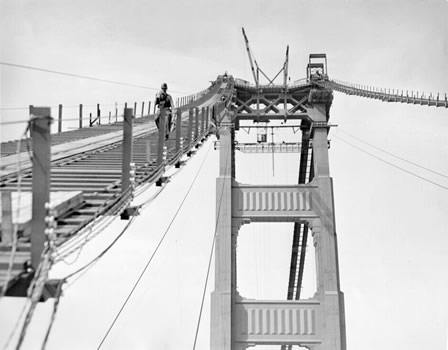
A long-span suspension bridge usually has tall towers. The height of the Bridge’s towers directs the tensile (pulling) forces in the main cables upward, so that the cables can efficiently do their job of holding up the roadway deck.
The 746-foot-tall (227-meter-tall) towers, the tallest bridge towers in the world when the Bridge was completed in 1937, were constructed by lifting prefabricated steel sections into place. A temporary support for cranes (climbing derrick) was built between the two legs of each tower, and cranes on the platform lifted sections of the tower into place at that level. Then the platform with its cranes was raised up the growing tower, and the process was repeated.
The 44,000 tons (40,000 metric tons) of steel in each tower was manufactured at Bethlehem Steel plants in Pennsylvania. The steel was shipped through the Panama Canal to the San Francisco Bay.
With the towers rising higher than a 60-story building – this was no place for a person with a fear of heights.
More Images
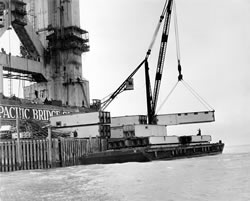 |
Prefabricated tower sections arrive by barge after traveling through the Panama Canal.
|
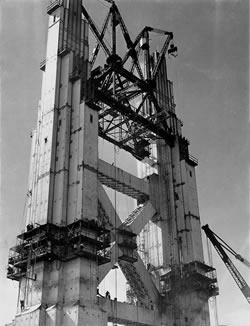 |
The traveling platform and cranes moved upward as the towers grew taller.
|
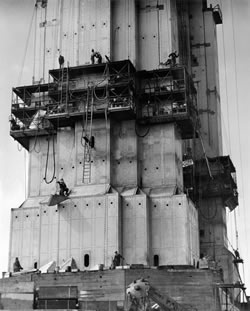 |
It took workers up to 20 minutes to climb a series of ladders to work on the towers.
|
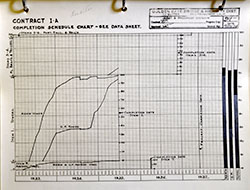 |
Completion Schedule Chart for the Towers from the Golden Gate Bridge, Highway and Transportation District - A chart from December 20, 1934 showing the percentage of completion of the construction of the two towers; the slower pace for the San Francisco Tower was due to the underwater construction required for its foundatio |
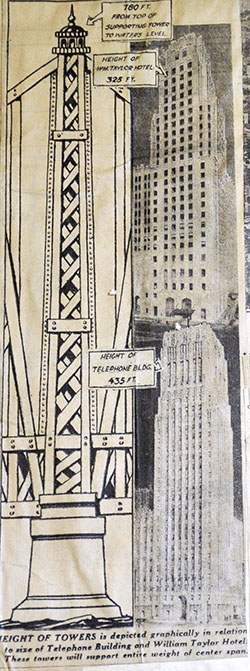 |
Comparisons Show Size of Gate Span from the Golden Gate Bridge, Highway and Transportation District - A newspaper article from the August 17, 1930 San Francisco Examiner; an illustration of a tower design that was part of the original design for the bridge (a combined cantilever-suspension bridge design) that was later rejected in favor of an all-suspension design. |
Explore this Topic Further
Tower Construction
Building the Golden Gate Bridge from Bethlehem Steel (all ages)
This promotional film, made by Bethlehem Steel, follows the steel elements of the Bridge from the steel fabrication factory in Bethlehem Pennsylvania through the Panama Canal and arrival in the San Francisco Bay Area. It provides original footage of the cellular construction of the towers, the riveting, and placement of the cable saddle, the construction of the deck, and the spinning of the cables. (26:35 minute video)
Golden Gate Bridge: An American Icon Turns 75 from www.nbcbayarea.com/ (all ages)
This video created for the 75th anniversary of the Golden Gate Bridge uses original footage to highlights aspects of the construction of the bridge. (5:16 minute video)
Patent for Bridge Tower Construction from HistoricBridge.org (grade 6-adult)
This links to a copy of patent number 2,054,995 dated September 22, 1936. The patent includes the drawings and documentation that Joseph B. Strauss used to obtain his patent for braces in the towers. The document also refers to patent number 1,967,381 that pertains to the cellular construction technique.
Using a Scale Model to Verify Calculations from the Golden Gate Bridge, Highway and Transportation District (GGBHTD)
Princeton University civil engineering professor Dr. Maria Garlock stands by the scale model of one of the Bridge towers that was fabricated and tested in the 1930s to verify the engineering calculations of the strength of the tower.
More photos from the Golden Gate Bridge, Highway and Transportation District (GGBHTD) (all ages)
See a few more photos of the construction of the Marin pier and tower.
Tower Forces
Suspension Cable Size vs. Tower Height from Golden Gate Bridge, Highway and Transportation District (GGBHTD) (all ages)
This exhibit designed by the Exploratorium, in the visitor area at the San Francisco end of the Bridge, demonstrates the advantages and disadvantages of tall towers. Visitors can feel how different tower heights affect the amount of tension acting through the main suspension cables.
Golden Gate Bridge: Balancing the Forces from PBS American Experience (grades 6-12)
The interactive tutorial allows users to explore the engineering and mathematical principles that govern the forces that act on the towers, cables, suspenders, anchorages, and roadway of a suspension bridge. The towers are in compression while the cables are in tension.
The Golden Gate Bridge – (grades 9-12, College)
This chapter by Thalia Anagnos found in Statics by Sheri Sheppard and Benson Tongue (Wiley, 2007) traces the loads through the elements of the Golden Gate Bridge. Several hands-on activities for exploring the loads on other bridge types are included at the end of the chapter.
Bridge Tower Statistics
Golden Gate Bridge Tower Statistics from Golden Gate Bridge, Highway and Transportation District (GGBHTD) (grades 3 through adult)
This web site summarizes design and construction statistics for the Golden Gate Bridge towers including height, weight, dimensions, deflections, and foundations.
List of Tallest Suspension Bridges from Wikipedia (all ages)
As of September 2014, the Golden Gate Bridge is the 14th tallest bridge in the world. This Wikipedia page provides a list of 93 of the tallest bridges in the world. Only two others on the list are in the United States: the Verrazano Narrows Bridge and the George Washington Bridge, both in New York City.